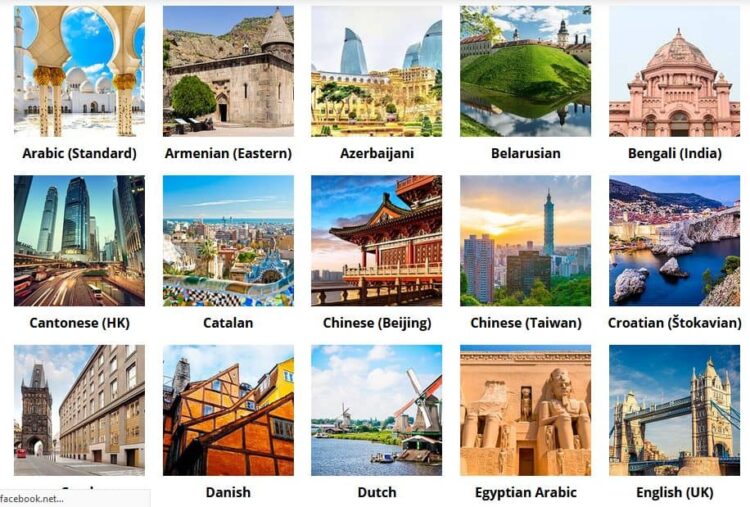Few resources cover as many different languages as Glossika does. Because of this, I was excited to try it out and see what it’s like to use.
For writing this review I decided to look at Italian, French, Dutch, and Swahili to see how they matched up across the board.
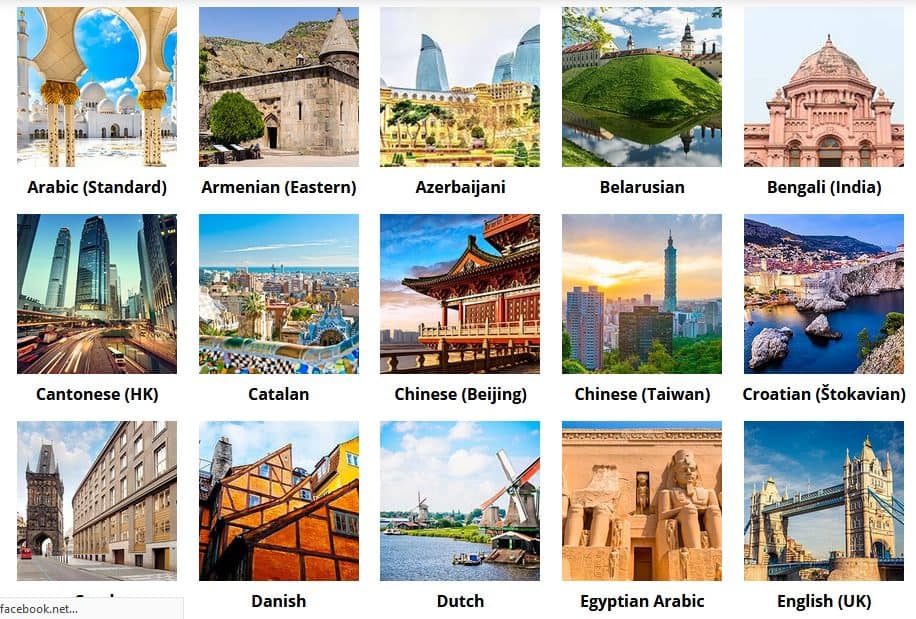
Glossika uses a spaced repetition approach whereby you listen to native speakers and repeat what they say after them. Through this intuitive method, you are supposed to pick up the grammar, pronunciation, vocabulary and language structure naturally.
As such, the resource is unsuitable for beginners and it is much more geared towards lower intermediate learners as you really need the basics before starting with Glossika.
There is a heavy emphasis on repetition and while there was a lot of audio from the native speakers of each language, it felt that the accompanying material was a bit haphazardly put together.
An intermediate learner would pick up some new vocabulary, improve their speaking rhythm and confidence, learn different sentences and generally improve their knowledge of the language. Perhaps more than other language learning resources, you’ll need to supplement Glossika with other resources to fill in the gaps.
While I can definitely find some value in using Glossika, the price is too high for what they offer.
Glossika relies on lots of repetition of sentences
While the audios across all of the different languages that Glossika offers cover the same material, the accompanying resources vary depending on the language. French for example has more exercises for learners to engage with than Swahili and Dutch learners. We will look at this more in a second.
The native speaker audio sentences are the main focus of each language that Glossika offers.
Here, an English speaker (or whichever language you choose) says a sentence and after a short pause, a native speaker of the language you are learning says it in that language. With the heavy amount of repetition, you are meant to intuitively pick up the language, memorizing the various sentences as you go.
I personally prefer to limit the amount of English used while studying another language. I found that I got much more out of Glossika when I either turned off the audio for the source language or changed it to another language that I wanted to review.
In this manner, it is slightly similar to Pimsleur in terms of the audio being the main focus and repetition being its key learning method.
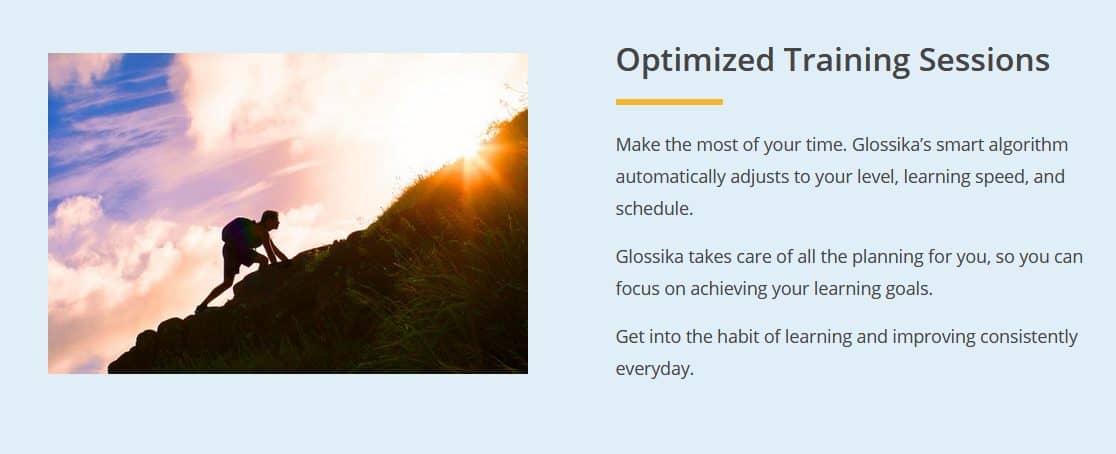
Glossika’s approach focuses on students listening to ´Glossika Mass Sentences´ – these sentences progress in difficulty and the intention is that learners pick up the grammar, pronunciation and sentence structure through spaced repetition.
Intended for people with not too much time on their hands, they can be listened to almost anywhere and learners can usually complete the different sentence sessions in less than half an hour.
There are lots of different subjects covered over the various audio sections and there are around 3000 sentences included for each language. Your progress is tracked by the number of ´reps´ (repetitions) you have done.
There are five types of exercises which I will talk more about later, for now though, they are typing, dictation, choice, translation, and fill in.
I found the exercises not to be particularly engaging and they contained too many errors. Let’s take a detailed look at them now.
The exercises leave a lot of room for improvement
Signing up for a free account is very easy and within seconds you’ll have access to all the languages available on Glossika. You can then try out their learning method for a thousand reps of each language if you so desire.
The page you land on at the start tells you about how Glossika’s method works and below all of this, you have the selection of languages before you. You then simply click on the one you wish to learn.
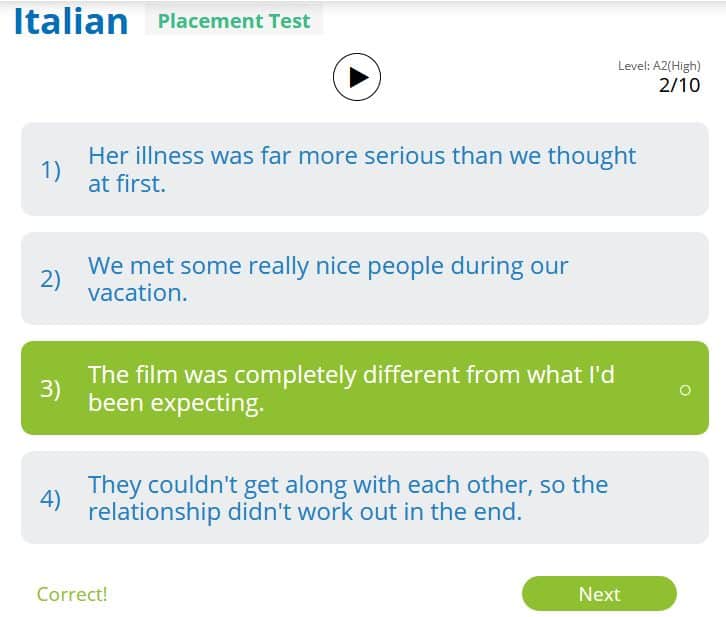
To gauge your knowledge of the language, you first undergo a placement test which serves to determine what level you should start at.
When I did this on my phone, for some reason I was only given three test sentences to see where I should begin with French, Dutch, and Swahili. I assume this was a bug because when I tried on the computer with Italian I was asked ten questions at the different levels available to test my comprehension skills.
Glossika tests you by giving you ten sentences to listen to in the language you´re learning and I assume they stop at some point if it´s clear that you can´t answer enough of the questions correctly. For Italian, I made a stupid mistake at B1 (high) and this was apparently enough to stop me from testing out the B2 level at all.
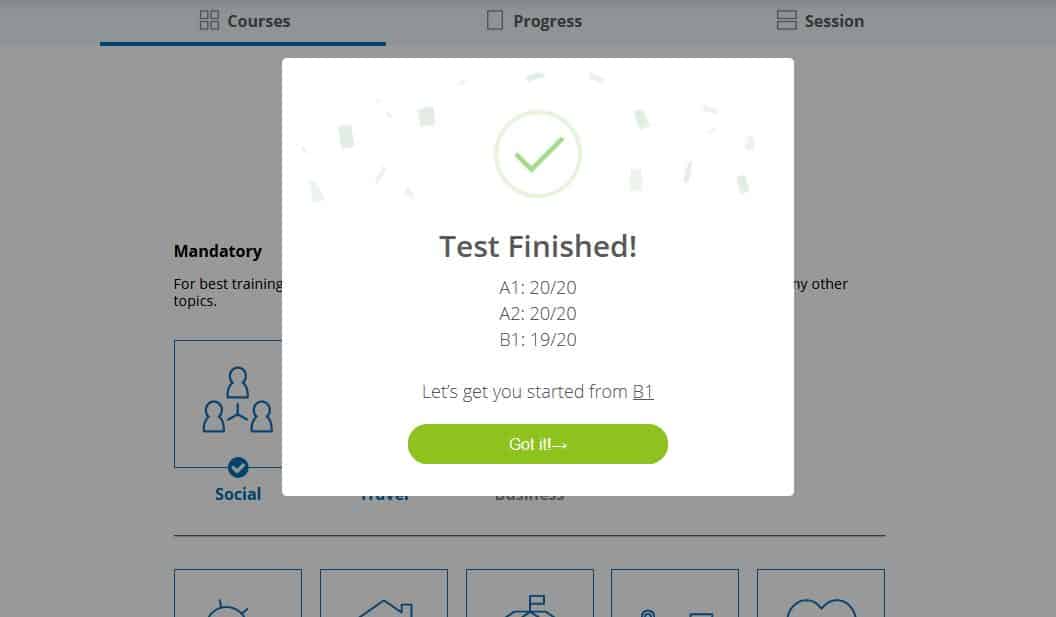
Once you have been placed at the appropriate level, you can then select the different topics that you are interested in learning about. After that, you´re good to go so simply click on the ´Start Session´ button which will take you to your first lot of sentences.
Glossika then gives you a quick review of how you can alter your preferences and navigate your way around the platform.

In these sessions, you listen to an English speaker say a sentence before a native speaker in the language you are learning then says the equivalent in that language. Again, you can edit this in the settings tab and change or remove the source language entirely, change the speed and adjust the interval between sentences.
You can skip sentences by clicking on the smiley face at the bottom to indicate that it is too easy.
It also helps to read the text that pops up below. You can turn off the translation, change it to IPA, Roman, or Sandhi.
To the top left corner, you will see how many reps you have left to do as well as the approximate amount of time that it will take to complete.
You can also turn on ´recording´ in your preferences and after both sentences are said, you can then repeat the sentence in your target language.
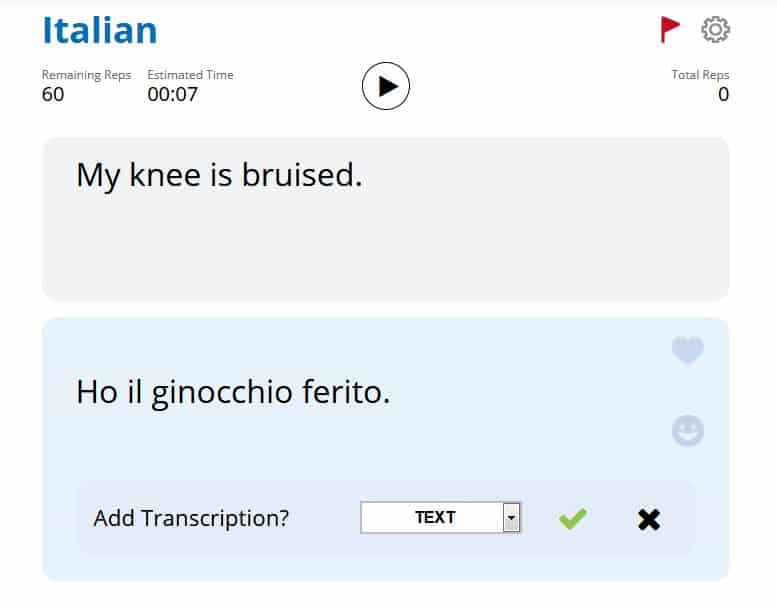
Once you have completed the session a box will pop up asking you for your feedback. Here, you can tell Glossika if it was too easy, at the right level or if it was too hard. You can also evaluate each individual sentence and give your feedback on how you found them.
While this is a good idea, in theory, there was no noticeable increase in difficulty after repeatedly putting too easy for everything.
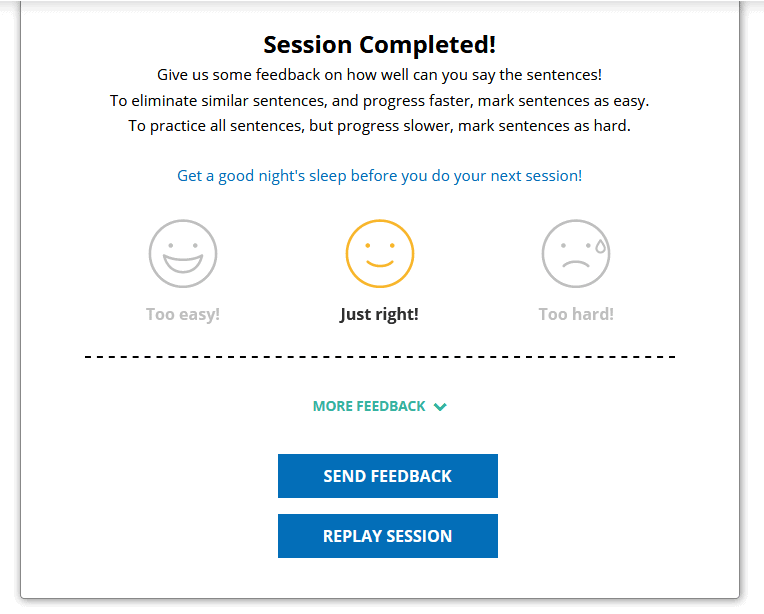
Glossika feels that you will take sentences in better and remember them for much longer if you sleep on the information you have just taken in. Consequently, they advise coming back the next day to continue your language learning.
When you next click on start session, you will find the sentences you have already learnt along with some new ones.
Through spaced repetition, you will find yourself being able to remember the sentences a lot easier. In fact, they’ll become sort-of automatic in that you’ll be able to instantly recall them.
While waiting for the next day to come (you can however just simply keep clicking start session if you wanted to), there are a couple of other ways for you to practice the language on Glossika, depending on which language you have chosen of course.
Typing
First up is the typing section. Here, you simply type what is said in the language you are learning.
Somewhat strange, however, the sentence is already written there for you so you can just simply copy it down. I suppose it shows you the spelling of everything but otherwise, it seems a bit pointless.
Annoyingly enough, no accents are provided to you on the platform so whatever you write will be marked incorrect if you are learning a language where they feature heavily.
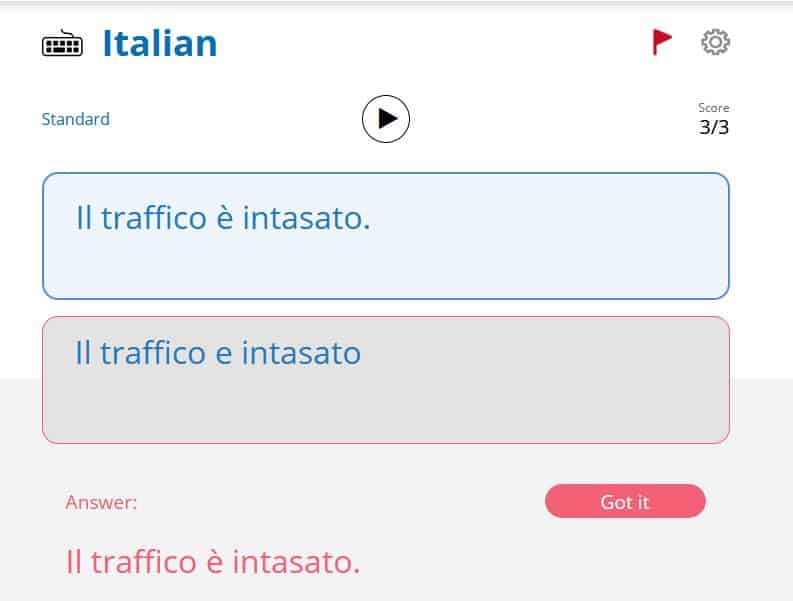
Dictation
The dictation section is almost exactly the same just without the sentence already appearing written before you. In Italian, there was hardly any difference between the lowest A1 level and the highest B2 level.
The recordings across the different languages I tried were invariably too fast, and unlike the principal audio sessions, there’s no way to moderate the speed.
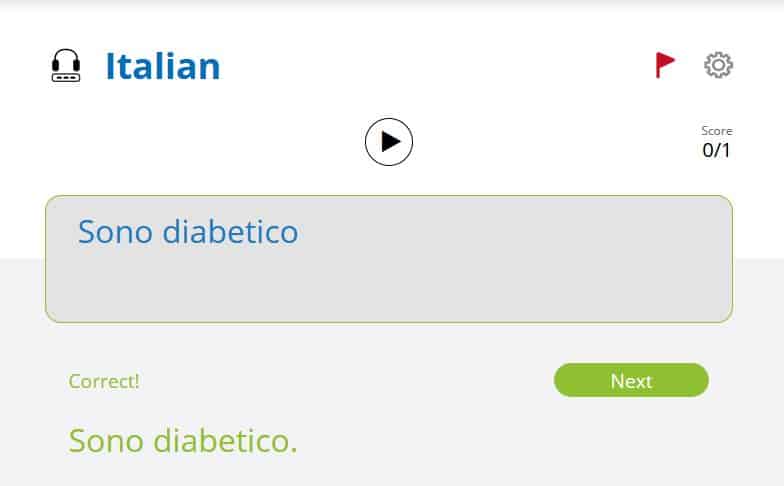
Choice
After this follows the ´choice´ section which is useless as far as I can tell. You see a short sentence written in IPA (I had to look this up – the International Phonetic Alphabet) and you have to match it to what it says in the language you´re learning.
I didn´t really see a use for this feature and I’m sure the vast majority of people won’t either. There may be a small minority of language learners that really like it though.

Translation
Next comes the translation section where you listen to a sentence in the language you´re learning and click on the correct answer in English from the multiple choices you can choose from. It´s okay I suppose but not that riveting.
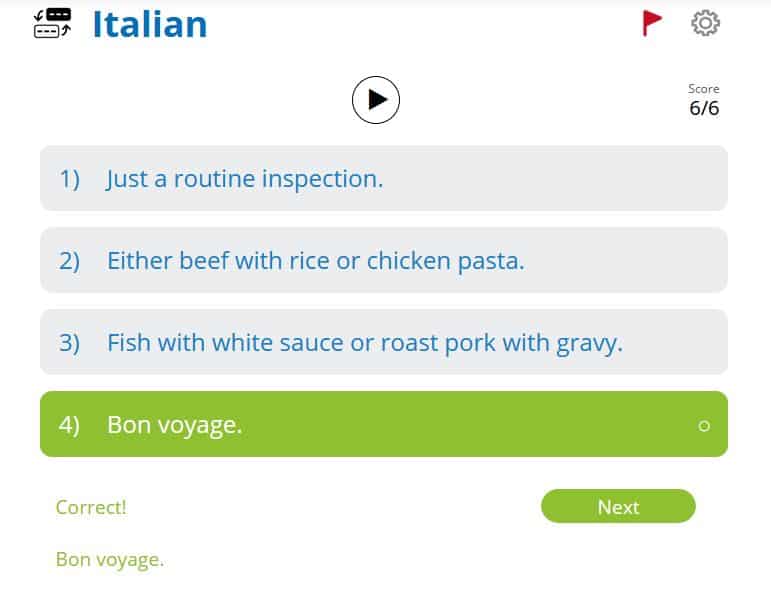
Fill in
The final section (if the language you´re learning has all of them) is the ´fill in´ bit where you type the word that is missing in the sentence after having listened to the audio. Again it´s not that great. This screenshot is from the highest level in Italian and many of the things they get you to fill in are really simple words.
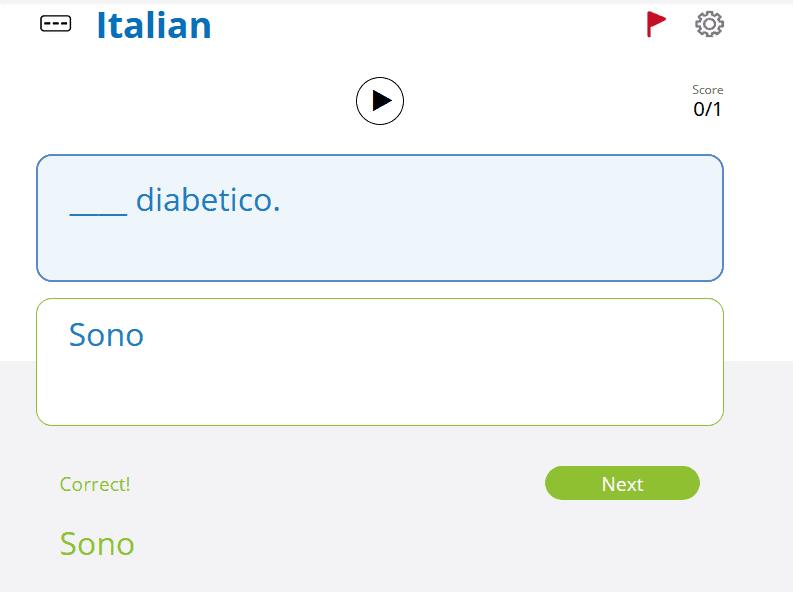
Click the link below to save $5 on a subscription to Glossika.
Try Glossika For Free
You may need to push yourself to get through the lessons
Unlike resources like Duolingo, you won’t find any of the gamification or external motivators to keep you going. You’ll need to motivate yourself. Glossika’s lessons aren’t particularly exciting, so if you easily lose motivation, there’s a good chance you’ll struggle to complete the lessons.

While there are elements of Glossika that I find to be useful, I was also disappointed by much of it.
I find that a real shame as I was initially really excited to try out their Swahili course because you don´t find so many platforms catering to learners of less popular languages.
While it is fantastic that there are so many languages available on Glossika, the fact that the core material is all the same and simply reworked into the different languages completely disregards the cultural context of learning a language.
Across the four languages I tried, the same sentences would come up with each of them and I found this a bit sad as it meant that the uniqueness of each language was being ignored.
To play devil’s advocate, the fact that the sentences are the same for each language makes it possible to learn a language from a ton of different languages. If the sentences differed for every language, this wouldn’t be possible.
I think Glossika is much better for people who are studying (or reviewing) 2 or more languages than for people who are only studying one language.
There were also mistakes floating around the different languages as well as mistranslations that could be found.
The poor Swahili speaker must have found it very strange when he was asked to say ´I´d rather be a dog than a cat´ when in actual fact the English says ´I´d rather have a dog than a cat´.
This hinted to me that the product was a bit hastily put together and, apart from the audio sessions; the other sections really lacked care and thought.
Glossika does acknowledge this to a certain extent as when you are listening to the audios you can flag mistranslations and incorrect sentences. As Glossika recently went through a re-design of their platform, I imagine that with time these errors will be fixed.

Using Glossika on my phone was mostly okay but I was a bit surprised that it apparently only took three sentences to determine what level I should be placed at.
While I assume this must have been a bug, it was slightly frustrating being stuck at the lower levels in Swahili, Dutch and French and I couldn’t find a way to change the settings to a higher level.
After having been put at a higher level for Italian though, there hardly seemed to be much of a difference between the lowest and highest levels.
While I am skeptical about Glossika´s teaching method, there was, unfortunately, a number of things that detracted from the quality of the audios themselves and, as these are the principal focus of each language I found this to be disappointing.
Although it is great that you listen to a native speaker of the language and thus improve your comprehension skills, all the languages I tried had monotonous speakers who really did not try at all to liven up the sentences.
There also only seemed to be one presenter for each language and all of the languages I tried had only male voices.
It would have been nice to have a bit more variation to keep things interesting and train your ear to different accents. The audios were mostly of a high quality but the Italian one was very crackly and warped.
Glossika boasts that its algorithms will tailor the course perfectly to your needs and that you can easily edit the difficulty level while listening to the audios. I constantly clicked that sentences were too easy but nothing ever seemed to come of it and I apparently continued learning at the same level.
Having now realized that the higher levels are really not that far removed from the lower ones, maybe they were taking my feedback into account and it just wasn´t very visible.
As aforementioned Glossika´s courses are not appropriate to beginners starting off in the language as there are absolutely no explanations regarding grammar throughout any of the courses. 
While I agree that grammar structures can be internalized to an extent, I think everyone would benefit from using a grammar book or other resources to gain a better understanding.
You really need the basics of the language before attempting Glossika´s method of spaced repetition.
Again, there are no explanations of what you are learning (bar the translation of the sentence) and this means that Dutch and Swahili learners will be confused as to why they are learning incorrect times.
Without any explanations available, it would be impossible to work out why in Swahili when you mean 10.40 you actually say 4.30!
After the audios, the rest of the features available to you (depending on the language) are really not that useful.
It felt sloppily put together and there was a great deal of similarity between a few of the exercises. For example, the typing section and dictation part were almost identical as far as I could tell.
While mistranslations and incorrect sentences popped up from time to time, another annoying feature in the translation section was that in the multiple-choice options, two almost identical answers would sometimes be available to you.
These small details all hint at a lack of care in the final product.
While there’s a lot of room for improvement, I think that you’ll certainly improve your speaking skills with Glossika.
It may feel like you’re just parroting sentences, but you’ll find that you’re able to combine different components of various sentences to form original thoughts.
In addition, after using Glossika, you should be able to recognize the sentences written down and understand them if they are said to you.
Although I can find Glossika’s method to be helpful, for $30 a month Glossika is significantly overpriced.
If you decide you want to use Glossika (and don’t have tons of cash to burn), I’d suggest spending a couple months and quickly make your way through the content.
Glossika is too expensive for what you get
Apart from the week-long trial period that gives you access to all of the materials across all the languages for free, you basically have two choices if you do decide that Glossika´s learning methods work for you.
The monthly subscription costs $30 per month and the annual subscription is $24.99 a month which comes out to a total of $299.88 for the year.
What exactly does your money get you?
Well, included in the packages are the professional native speaker recordings, a weekly progress report that you get sent, professional pronunciation transcriptions, unlimited reps for all the languages that they cover, full access to extended learning tools and unlimited offline downloads.
There is also an ENTERPRISE subscription which caters for groups but we won´t go into that here.
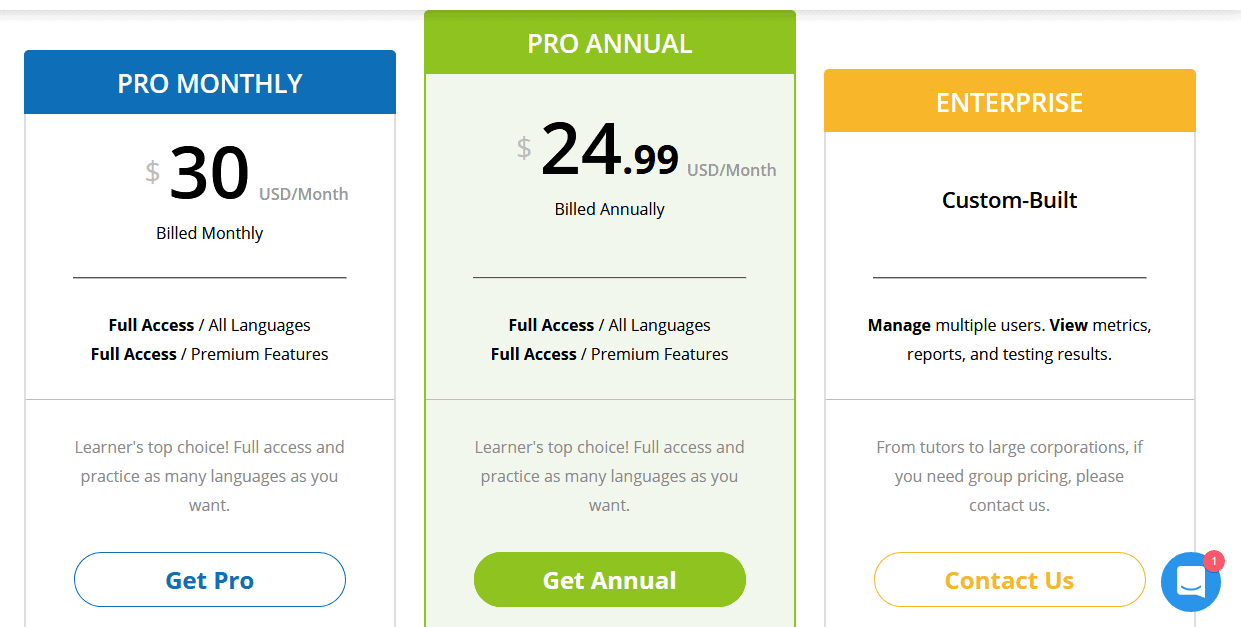
What does that REALLY mean though?
As a subscriber, you will get unlimited access to the native speaker recordings which are the main focus of each lesson as well as the accompanying sections that complement them.
What is cool is that you get this for all the languages available on Glossika.
When you dig deep into one language, you see the flaws that are there in terms of spelling mistakes and mistranslations and, with the monotonous native speakers; I think many people would quickly tire of repeating its exercises.
I think Glossika is overpriced but fairly useful for learning one language, especially if it’s a less popular one. People studying, or reviewing, two or more languages would benefit the most.
Glossika is useful but limited
All in all, Glossika was fairly disappointing to use which is a shame considering all the languages that they have on offer.
While there are lots of improvements that can be made, the fact that they are still refining their product gives me hope that it will gradually get better to use. As users flag incorrect sentences and mistranslations, the course material will slowly be improved upon.
Perhaps you could find enough value in using it strenuously for a couple of months if you’ve struggled to find the motivation to practice speaking the language you’re learning.
Polyglots may find value in using Glossika long-term, but for anyone else, $300 for a year is just too much.
For everyone else, I’d consider Glossika to be a potentially useful supplement to your study routine but far from sufficient in isolation.
Click the link below to save $5 on a subscription to Glossika.

